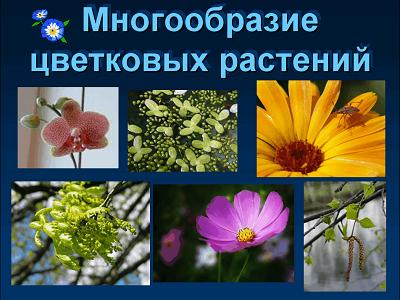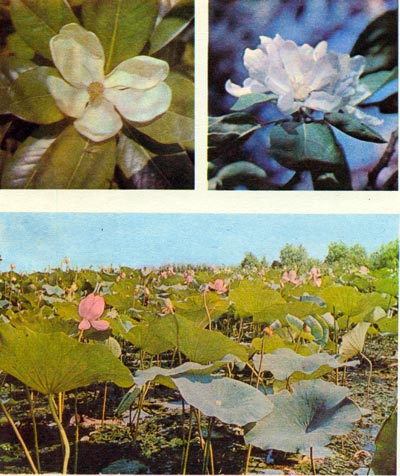Plants of the Angiosperms department (the largest in the number of species - more than 250 thousand) are distributed on all continents, in all climatic zones and in various environmental conditions; these are the dominant plants of our time. The following factors allowed them to become the dominant group:
- the formation of seminal primordia inside the ovary, the walls of which after fertilization and seed formation turn into fertilization and together with the seed make up the fetus;
- in all angiosperms double fertilization and secondary endosperm;
- the presence of the stigma of the pestle, to which the pollen gets, before reaching the seed germ;
- the presence of flowers - the flower proved to be an effective formation for ensuring reproduction.
These are the main hallmarks of angiosperms.
The Angiosperms division is divided into two classes: Dicotyledonous and Monocotyledonous.
Dicotyledons have an embryo with two cotyledons, the number of parts in the flower in each circle is a multiple of five or four, the leading bundles in the stem are arranged in a circle (ordered), the venation of the leaves is reticulate; the root system is pivotal.
Monocotyledons have an embryo with one cotyledon, the number of parts in the flower in each circle is a multiple of three; conductive bundles are randomly located in the stem; venation of leaves arched or parallel; the root system is fibrous (consists of accessory roots).
Characterizing the plant, all the signs must be considered in a complex. On one basis, it is impossible to recognize monocotyledonous or dicotyledonous plants, because there are exceptions for each of the characteristics. Dicotyledons are much more than monocotyledons (about 4 times). Each class is divided into subclasses (dicotyledonous - 8 subclasses, monocotyledonous - 3). Subclasses are divided into orders, and those into families. There are more than 250 families in the department. Not all families are found in our country: there are no species from purely tropical families and purely arctic. The most species nowadays are Astrovian (22 thousand) from dicotyledonous families and Orchidic (20 thousand) from monocotyledonous.
Variety of angiosperms, their classification
Systematics is a science that allows you to better understand the diversity of living organisms. In taxonomy, systematic categories are distinguished that are combined with similar characteristics and a common origin. Systematic categories (taxonomic units) have ranks: the lower the rank, the greater their number: Department - class - order - family - gender - species.
A view is the basic unit of taxonomy. Each species necessarily applies to other taxonomic units. Plants of one species can produce offspring, but of different species - as a rule, they cannot, they do not cross, even if they live nearby. Therefore, a large number of species is preserved on the planet - 250 only among flowering ones. The name of the species consists of two words: the first is the name of the genus, the second is the species itself (common oak, maple, deciduous dandelion, etc.) ..
"General Biology. Grade 11." V.B. Zakharov et al. (GDZ)
The evolutionary paths of life in the Mesozoic era
Question 1. When did flowering plants arise?
In the Mesozoic era, earth-forming processes occur on Earth. The Urals, Tien Shan, Altai appear, intensive mountain-building processes are underway (Alps, Andes, Himalayas). Climate is drying up further and the seas and oceans are shrinking. In the Triassic, giant ferns, tree-like horsetails, and mules die out. Gymnosperm plants flourish. In the Jurassic period, seed ferns die out and the first angiosperms appear, which in the Cretaceous period gradually spread to all continents.
Question 2. Indicate the evolutionary benefits of flowering plants.?
The evolutionary advantages of flowering plants compared to seed ferns and gymnosperms are as follows:
1) the presence of a developed conductive system;
2) the flower attracts pollinators, which ensures the reliability of cross-pollination;
3) the presence of double fertilization, due to which the triploid endosperm develops, and the embryo receives proper nutrition during development;
4) the nucleus is protected by shells.
Question 3. In what period of the Mesozoic era and due to what aromorphoses did mammals arise?
The emergence of mammals is associated with a number of large aromorphoses that have appeared in representatives of one of the subclasses of reptiles. Aromorphoses that defined the formation of mammals as a class include:
1) an increase in the anterior (motor) parts of the brain and cerebellum; the development of the cortex and the appearance of convolutions;
2) strengthening the connection of the belt of the hind limbs and the spinal column in the sacral region - from 2 to 5 vertebrae; limbs are transferred from the sides of the body under the body and lengthen;
3) the formation of a four-chamber heart and the complete separation of the circles of blood circulation;
4) the appearance of alveolar lungs, characterized by an increase in the gas exchange surface and targeted delivery of oxygen to this surface (bronchial tree);
5) warm-bloodedness - the ability to maintain a constant body temperature;
6) lengthening and differentiation of the intestinal tube, differentiation of teeth;
7) the appearance of a loop of Henle in the nephron of the secondary (pelvic) kidney;
8) coat, performing the function of a heat insulator;
9) intrauterine development of offspring and feeding the young with milk.
Mammals appeared in the Triassic, but could not compete with predatory dinosaurs and for 100 million years they occupied a subordinate position.
general characteristics
Angiosperms make up the most perfect and most numerous group of higher plants, including approximately 250 thousand species distributed throughout the globe, especially in the humid tropics.
 In Belarus, there are 112 families, 500 genera and more than 1750 species (excluding numerous species, forms and varieties of introduced plants, adventitious species and other flowering plants).
In Belarus, there are 112 families, 500 genera and more than 1750 species (excluding numerous species, forms and varieties of introduced plants, adventitious species and other flowering plants).
It is assumed that angiosperms arose at the beginning of the Cretaceous period of the Mesozoic era (about 125 million years ago). By the end of the Cretaceous, angiosperms dominate the plant world due to their high ecological plasticity and many advantages over other higher plants.
The most important sign of angiosperms is the presence of a flower -modified and limited in growth spore-bearing shoot, adapted for reproduction. The appearance of the flower has played an extremely important role in their evolution.
Ovules in flowering plants (unlike gymnosperms) are enclosed in the cavity of the ovary of the pestle and are thereby protected.
Gametophytes (female - germinal bag, male - pollen grain) are extremely simplified and develop much faster than gymnosperms, and therefore they have lost gametangy - anteridia and archegonia. In addition, gametophytes are completely dependent on the sporophyte and are always under its protection, while in bryophytes and some ferns, the gamete-fit is not protected and dries easily.
![]() Flowering plants are characterized by double fertilization, as a result of which a zygote is formed, giving rise to the embryo, and a trishyoid cell, from which the endosperm is subsequently formed. In gymnosperms, endosperm is formed in the ovule before fertilization, regardless of whether the embryo is formed or not, that is, it does not matter if there is a need for nutrient tissue or not. In angiosperms, the simultaneous development of the embryo and endosperm avoids the unnecessary waste of plastic substances and energy if the embryo does not form.
Flowering plants are characterized by double fertilization, as a result of which a zygote is formed, giving rise to the embryo, and a trishyoid cell, from which the endosperm is subsequently formed. In gymnosperms, endosperm is formed in the ovule before fertilization, regardless of whether the embryo is formed or not, that is, it does not matter if there is a need for nutrient tissue or not. In angiosperms, the simultaneous development of the embryo and endosperm avoids the unnecessary waste of plastic substances and energy if the embryo does not form.
Seeds are enclosed in the fruit (hence the name "angiosperms") and are reliably protected from adverse environmental conditions. In addition, due to the uniqueness of the fruit, their distribution is provided by birds, mammals, insects, as well as wind, water, etc.
The angiosperm sporophyte is extremely diverse and represented by various life forms; trees, shrubs, shrubs, shrubs, shrubs, vines, one and perennial grasses.
Angiosperms have a highly organized conductive system: the xylem includes more advanced conductive elements - real vessels, while in gymnosperms they are represented by tracheids. In addition, unlike all other higher plants, angiosperms have sieve-shaped phloem tubes with companion cells. Their appearance increased the efficiency of the movement of photosynthesis products from leaves to the stem and root, and through vessels that are much wider than the tracheid, faster movement of water and dissolved mineral salts from the root to the stem and leaves takes place.
 The first seed plants - gymnosperms - were passively pollinated. Their pollen was carried by the wind and only happened to be around ovules. The evolutionary success of flowering plants was largely due to the parallel development of them and various animals. They exerted a selective effect on each other and in many respects determined the evolution of their and partners. The bright colors of the flowers, fragrant aroma, edible pollen and nectar - the properties inherent in plants, were both means to attract pollinating animals. Flower adaptation, as a rule, was aimed at maximizing the chances for pollen transfer by insects. This process is more reliable than pollination by wind. In particular, plants pollinated by insects do not need such large amounts of pollen as when pollinated by wind.
The first seed plants - gymnosperms - were passively pollinated. Their pollen was carried by the wind and only happened to be around ovules. The evolutionary success of flowering plants was largely due to the parallel development of them and various animals. They exerted a selective effect on each other and in many respects determined the evolution of their and partners. The bright colors of the flowers, fragrant aroma, edible pollen and nectar - the properties inherent in plants, were both means to attract pollinating animals. Flower adaptation, as a rule, was aimed at maximizing the chances for pollen transfer by insects. This process is more reliable than pollination by wind. In particular, plants pollinated by insects do not need such large amounts of pollen as when pollinated by wind.
One of the factors of widespread angiosperms and an increase in their diversity is biochemical co-evolution. In some groups of angiosperms, the ability to form secondary metabolites (alkaloids, quinones, essential oils, flavonoids, crystals of calcium oxalate, etc.) - toxic substances that protect them from herbivorous animals - has developed.
As a result of the emergence of various life forms (trees, shrubs, grasses, etc.), angiosperms are the only group of plants that form complex multi-tiered communities, or phytocenoses. This contributed to a more complete and intensive use of environmental resources, the successful conquest of new territories and the development of new habitats.
A source : ON. Lemeza L.V. Kamlyuk N.D. Lisov "Biology manual for applicants to universities"
